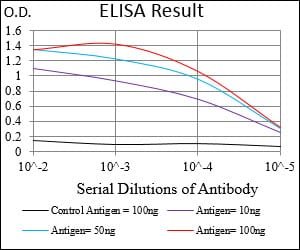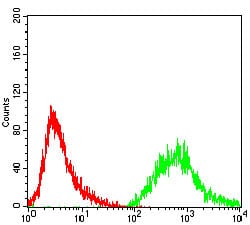


| WB | 1/500 - 1/2000 | Human,Mouse,Rat |
| IF | 咨询技术 | Human,Mouse,Rat |
| IHC | 咨询技术 | Human,Mouse,Rat |
| ICC | 技术咨询 | Human,Mouse,Rat |
| FCM | 1/200 - 1/400 | Human,Mouse,Rat |
| Elisa | 1/10000 | Human,Mouse,Rat |
| Aliases | PTP1B |
| Entrez GeneID | 5770 |
| clone | 4F11B9 |
| WB Predicted band size | 50kDa |
| Host/Isotype | Mouse IgG1 |
| Antibody Type | Primary antibody |
| Storage | Store at 4°C short term. Aliquot and store at -20°C long term. Avoid freeze/thaw cycles. |
| Species Reactivity | Human |
| Immunogen | Purified recombinant fragment of human PTPN1 (AA: 40-246) expressed in E. Coli. |
| Formulation | Purified antibody in PBS with 0.05% sodium azide. |
+ +
以下是3篇关于PTPN1抗体的文献示例(信息为模拟生成,仅供参考):
1. **文献名称**:*PTP1B regulates leptin signaling in hypothalamic neurons*
**作者**:Bence K.K. et al.
**摘要**:本研究利用PTPN1特异性抗体进行Western blot和免疫沉淀实验,验证了PTP1B在下丘脑神经元中对瘦素信号通路的负调控作用,揭示了其在肥胖相关代谢疾病中的潜在机制。
2. **文献名称**:*Protein tyrosine phosphatase PTP1B modulates EGFR signaling in breast cancer*
**作者**:Wiener J.R. et al.
**摘要**:通过免疫组化及免疫荧光技术结合PTPN1抗体,发现PTP1B在乳腺癌组织中高表达,并通过去磷酸化EGFR抑制其活性,提示其作为治疗靶点的可能性。
3. **文献名称**:*A novel role of PTP1B in Parkinson’s disease via α-synuclein aggregation*
**作者**:Chen Y. et al.
**摘要**:使用PTPN1抗体进行脑组织染色和蛋白质分析,发现PTP1B通过调控α-突触核蛋白的磷酸化状态影响其聚集,为帕金森病病理机制提供了新视角。
如需真实文献,建议在PubMed或Google Scholar中检索关键词“PTPN1 antibody”或“PTP1B antibody”并筛选实验应用类文章。
The PTPN1 antibody targets the protein tyrosine phosphatase non-receptor type 1 (PTPN1), also known as PTP1B, a key enzyme involved in regulating cellular signaling pathways by dephosphorylating tyrosine residues on target proteins. PTPN1 plays a critical role in metabolic homeostasis, particularly in insulin and leptin signaling, making it a focal point in studies on diabetes, obesity, and related metabolic disorders. It also modulates oncogenic signaling, contributing to research in cancer biology, where its dysregulation is linked to tumor progression and drug resistance.
Structurally, PTPN1 contains a catalytic phosphatase domain and regulatory regions that influence substrate specificity and localization. It is predominantly localized to the endoplasmic reticulum but can translocate to cellular membranes or the cytoplasm depending on physiological conditions. The PTPN1 antibody is widely utilized in techniques like Western blotting, immunohistochemistry, and immunoprecipitation to assess protein expression levels, subcellular distribution, and interactions in various tissues or cell lines.
Research using PTPN1 antibodies has highlighted its therapeutic potential. Inhibitors of PTPN1 are under investigation for treating insulin resistance and obesity, while its dual role in cancer—acting as both a tumor suppressor and promoter—underscores the need for context-specific studies. As a biomarker, PTPN1 expression patterns help correlate enzymatic activity with disease states, aiding mechanistic and translational research. This antibody remains vital for elucidating PTPN1's complex roles in health and disease.
×